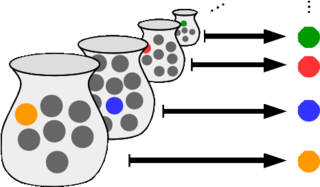In mathematics, a partially ordered set P is said to have Knaster's condition upwards (sometimes property (K)) if any uncountable subset A of P has an upwards-linked uncountable subset. An analogous definition applies to Knaster's condition downwards.

Mathematics includes the study of such topics as quantity, structure, space, and change.

In mathematics, especially order theory, a partially ordered set formalizes and generalizes the intuitive concept of an ordering, sequencing, or arrangement of the elements of a set. A poset consists of a set together with a binary relation indicating that, for certain pairs of elements in the set, one of the elements precedes the other in the ordering. The word "partial" in the names "partial order" or "partially ordered set" is used as an indication that not every pair of elements needs to be comparable. That is, there may be pairs of elements for which neither element precedes the other in the poset. Partial orders thus generalize total orders, in which every pair is comparable.
In mathematics, an upwards linked setA is a subset of a partially ordered set, P, in which any two of elements A have a common upper bound in P. Similarly, every pair of elements of a downwards linked set has a lower bound. Every centered set is linked, which includes, in particular, every directed set.
The property is named after Polish mathematician Bronisław Knaster.

The Poles, commonly referred to as the Polish people, are a nation and West Slavic ethnic group native to Poland in Central Europe who share a common ancestry, culture, history, and are native speakers of the Polish language. The population of self-declared Poles in Poland is estimated at 37,394,000 out of an overall population of 38,538,000, of whom 36,522,000 declared Polish alone.

A mathematician is someone who uses an extensive knowledge of mathematics in his or her work, typically to solve mathematical problems.

Bronisław Knaster was a Polish mathematician; from 1939 a university professor in Lwów and from 1945 in Wrocław.
Knaster's condition implies the countable chain condition (ccc), and it is sometimes used in conjunction with a weaker form of Martin's axiom, where the ccc requirement is replaced with Knaster's condition. Not unlike ccc, Knaster's condition is also sometimes used as a property of a topological space, in which case it means that the topology (as in, the family of all open sets) with inclusion satisfies the condition.
In order theory, a partially ordered set X is said to satisfy the countable chain condition, or to be ccc, if every strong antichain in X is countable.
In the mathematical field of set theory, Martin's axiom, introduced by Donald A. Martin and Robert M. Solovay (1970), is a statement that is independent of the usual axioms of ZFC set theory. It is implied by the continuum hypothesis, but it is consistent with ZFC and the negation of the continuum hypothesis. Informally, it says that all cardinals less than the cardinality of the continuum, , behave roughly like . The intuition behind this can be understood by studying the proof of the Rasiowa–Sikorski lemma. It is a principle that is used to control certain forcing arguments.
In topology and related branches of mathematics, a topological space may be defined as a set of points, along with a set of neighbourhoods for each point, satisfying a set of axioms relating points and neighbourhoods. The definition of a topological space relies only upon set theory and is the most general notion of a mathematical space that allows for the definition of concepts such as continuity, connectedness, and convergence. Other spaces, such as manifolds and metric spaces, are specializations of topological spaces with extra structures or constraints. Being so general, topological spaces are a central unifying notion and appear in virtually every branch of modern mathematics. The branch of mathematics that studies topological spaces in their own right is called point-set topology or general topology.
Furthermore, assuming MA(), ccc implies Knaster's condition, making the two equivalent.



